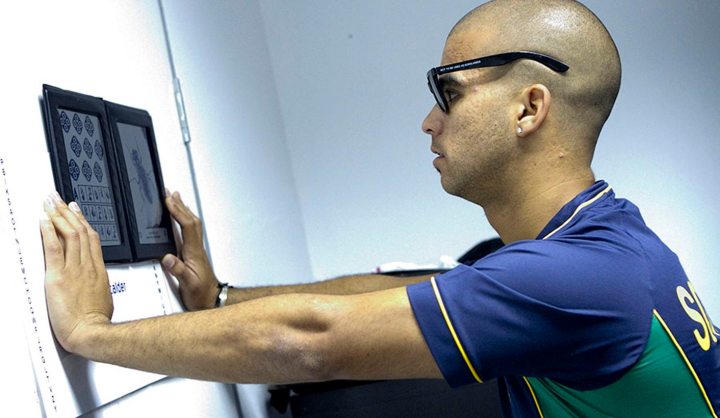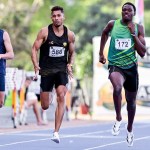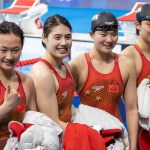Sport
Seeing & Believing: EyeGym, where Vision meets Innovation

By improving how the eye sees and understands the world around us, the cognitive process of seeing and doing, and then effectively and accurately responding to what is being seen, elite athletes are able to separate themselves from the competition. By DANIEL GALLAN for CONQA SPORT.
This article first appeared on Conqa Sport and has been republished with permission.
Throughout South Africa’s isolation from the rest of the sports-world during apartheid, countless talented athletes were left in the doldrums. With their gifts and abilities confined to the southern tip of Africa, many left their homes and loved ones in order to forge a career in the sports they loved.
In 1987, a young Sherylle Calder packed her hockey gear and travelled to Europe; playing anywhere she could find a game. Her talent was duly noted, and many clubs around the continent, most notably in England, Germany, and the Netherlands, clamoured for Calder’s participation. Her ability to pick a pass was unrivalled, and her uncanny knack of being in the right place at the right time was a gift from Africa. She would later go on the represent her country 50 times.
While playing in England, a team mate’s father commented how Calder was the only elite hockey player he had ever seen that did not run on the field. That was not true, as no elite player can get away with an idle work rate. What he meant was that Calder appeared to get around the field effortlessly. Think how footballers like Italian midfielder, Andrea Pirlo and his Iberian counterpart, Xavi (Xavier Hernández Creus), who was a mainstay in Barcelona and Spain’s all conquering side of the past decade or so, have effortlessly pulled the strings from he midfield.
“That was the switch on for me. I ran like crazy but his perception was that I didn’t,” says Calder, from her base at the Stellenbosch Academy of Sport. “I realised that there must be something different in my game. I was determined to find out what it was.”
She began a process of backtracking and sought to figure out why she had an apparent natural ability that others did not have. From a young age, Calder was constantly comparing herself to others and analysed the way she was brought up. Through her studies, which included a PhD in Sport Science from the University of Cape Town in 1999, her exceptional peripheral vision, and her reaction to what her eyes focussed on, Calder reduced the process to three steps: see with your eyes, cognitively process what you are seeing, and then act as quickly and accurately as possible to achieve your goal. Thus, EyeGym was formed.
“The process is not a natural ability that some people have, but rather a trained skill that many people don’t even know they have been training,” Calder says. “This skill could have been developed from simple tasks such as climbing a tree. When you climb a tree you have to put your body, your hands, your feet, in the right position and you learn to coordinate accordingly. It could have been developed from playing games with friends or having an older sibling that challenged you on a sports field.”
Calder has found that all the athletes that she has worked with have a common trait that could explain a perceived natural ability. She says, “I’ll ask (the athlete) about some of their background, and how they grew up and I will always find a correlation between them. There is a causal relationship to what we perceive as a natural ability and a particular conditioning at a young age. They don’t even realise they’ve been training a skill their whole life.”
Calder started EyeGym in 1996, and has since worked with thousands of elite athletes, developing a perhaps the most impressive résumé in world sport. They have two Rugby World Cups under their belt after working with England in 2003, then South Africa in 2007, as well as with Australia’s 2003 Cricket World Cup triumph. The 2012 British Open winner, Ernie Els, is a client, as are pro golfers Retief Goosen, Sergio Garcia, Branden Grace, Robert Karlsson and Justin Rose. Formula 1 driver Valtteri Bottas identified the benefits of EyeGym back in 2012, while still a GP3 driver, and drove several hours to have a meeting with Calder when she was working with McLaren in his home country, Finland. Since working with EyeGym, the young Finn has become a GP3 champion, earned a permanent seat in an F1 car with Williams, and is widely regarded as a future world champion.
The list of athletes that Calder and her team have worked with and improved is as impressive as it is vast. “We’ve worked with English Premier League teams, international hockey teams, Grand Slam winners in tennis, Olympic teams, international and domestic rugby and cricket sides, volleyball, water polo, netball, surfing, canoeing, umpires and referees, you name it,” she says. “If you play a sport, and you use your eyes, EyeGym can improve your performance. If you haven’t trained specifically, you’re underperforming.”
The first step involves using your eyes to see what is happening on the field. The eye is a muscle and needs to be trained; tired eyes can have a negative impact on performance. When Justin Rose worked with EyeGym in 2003, his first session resulted in tired eyes. When your eyes get tired, the brain automatically gets tired and sleepy. As a result, the muscles in your body get sluggish and your reaction time and ability to make quick decisions is reduced. “We train the eyes to maintain their strength over the duration of the task,” adds Calder. “If your eyes are going to be slow, the body will be slow. The eyes lead the body and the body cannot go where the eyes do not tell it to go.”
Former South African cricket captain Hansie Cronje was one of the fittest athletes in the country when the Proteas worked with EyeGym in the late 1990s. However, he struggled with certain eye exercises as he had never trained those particular muscles. This reinforced the idea that this is not simply a natural ability that fit and talented athletes possess.
The next process involves another factor, perhaps the most important: the brain. Studies have shown that the brain can be developed and actually grows in mass through training and conditioning. As a beginner, a 10-minute session at EyeGym would see you making roughly 500 – 800 decisions based on things you have never seen before. Imagine what it is like for Bottas, hurtling through the streets of Monaco, having to make split-second decisions over and over again throughout a race. Being able to see something new, and adjust accordingly is a skill EyeGym trains.
“When Bryan Habana scored an intercept try in the 2007 semi-final against Argentina, many pundits and experts celebrated what a natural talent he was,” says Calder. “I knew that his interception, and many others during that period, was a result of many hours Bryan put in with me at EyeGym. It didn’t happen by accident.” Habana saw his opponent make a move, and in a fraction of a second made a judgment to step out of line and go for the intercept. He responded to a brand new situation as the result of hours of training at EyeGym.
Os du Randt, one of only six players to have won the Rugby World Cup twice, was impeccable with his tackling during the 2007 campaign. In his final tournament, will-power and a desire were cited as reasons for his accuracy, but it was due to Calder’s work with the big man. Since Du Randt was able to see the correct line that he needed to run in order to make the tackle, he was able to cover less ground on the field. Any large player, in any sport, will tell you how metres saved means energy saved. “If you’re 30cm off a tackle, you won’t effectively make that tackle,” says Calder. “In all sports, a few centimetres can make all the difference and being able to accurately see those centimetres and react to them is what we train.”
It’s important to understand that EyeGym does not train eyesight. It is seeing what needs to be seen, and then acting on that. Bottas has not improved his eyesight. He has improved his ability to differentiate between what he needs to concentrate on and what he needs to ignore. By doing so he is able to identify, to the centimetre, the correct line he needs to take into corners. Retired Springbok, Guthro Steenkamp, told Calder that he had seen more in one match than he had during his whole career, when he left the field during a match in 2005 after working with her.
It is incredible to think that the same programme can improve the performances of athletes from all codes. Golf and F1 could not be further apart in terms of speed and reaction times needed but EyeGym has improved athletes in both sports. Of course, generic programmes need to be modified the closer you get to the apex of the pyramid, but then again, so does any fitness or skills regime.
EyeGym has also recently partnered with Discovery Insure, a branch of one of South Africa’s leading insurance companies. Truck drivers who drive long distances have benefitted from EyeGym.
EyeGym have also branched out to disadvantaged communities in South Africa, showcasing the potential of the programme. Almost 1, 500 children from rural communities around the Breedekloof Valley have started with EyeGym, in collaboration with Du Toitskloof Wines, and the results have been astounding. “We’re changing people’s lives,” Calder says. “Since they’ve started, the speed and accuracy of their reading has improved dramatically. Not only that, but their ability to process the information and use the information has improved. Their academic results have opened so many more doors for them.”
From the dusty streets of Rawsonville, to the glitz and glamour of the Monaco Grand Prix, EyeGym’s impact on countless lives is felt worldwide. With Calder and her team improving on their programme every day, and new technology pushing the ceiling higher and higher, there is no telling how many more lives the programme will change. All the trophies, all the titles, all the feel good stories can be traced back to one English father and his passing comment about an inquisitive, competitive South African girl. DM
Photo by EyeGym.



















 Become an Insider
Become an Insider